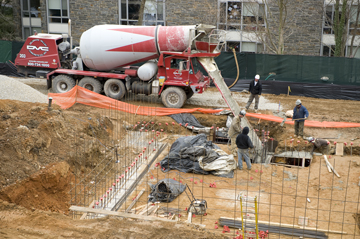Fly Ash Concrete
Over the past several months, staff, volunteers, and visitor have been able to watch the construction progress on the Wister Education Center and Greenhouse. During the winter months we observed how large concrete truck delivered 8,038 lbs of concrete to form the foundation walls, piers, and slabs. As part of our effort to receive silver LEED certification, this concrete contained 3% fly ash.
Fly ash is a fine, glass-like powder recovered from gases created by coal-fired electric power generation. U.S. power plants produce millions of tons of fly ash annually, which is usually dumped in landfills. The use of this bi-product reduces the amount entering our landfills.
Fly ash concrete was first used in the U.S. in 1929 for the Hoover Dam, where engineers found that it allowed for less total cement. It is now used across the country. Fly ash is an inexpensive replacement for the Portland cement used in concrete, while it actually improves strength, segregation, and ease of pumping of the concrete. Fly ash is also used as an ingredient in brick, block, paving, and structural fills.
A limitation to the use of fly ash is the day temperature must reach 50 degrees or higher for the concrete to set properly. Because our pouring occurred during the cold temperatures of February and March, this effort presented the greatest challenge for the project to date. With the help of a third party monitoring group, the pouring of our foundation was completed within schedule.
Check out other posts on our LEED certification and LEED certified professionals. Look for future posts on our other sustainable efforts in the building of the Wister Education Center and Greenhouse.







Barbara Shaw
Posted at 17:55h, 04 JunePerhaps we could try fly ash in hypertufa. Another subsitute for peat?